| |
|
|
|
back to Drum Tower main |
 |
| About designing the Beijing Drum Tower
|
|
When I was travelling in Beijing during the nine years I lived there, one of my favourite places was the area near the Upper lakes, which is ruled over by two ancient towers, the Bell Tower and the Drum Tower. Many years I thought about building a model of the Bell Tower. But, I thought, the Drum and Bell Tower together are a pair that can't be separated. I thought having both would be cool, but felt doing the Drum Tower with all its ornaments would be a pain...
So I figured, I better do the Drum Tower first, because I worried after building the Bell Tower, I wouldn't want building the Drum Tower any longer. This way, the more fun one would be second.
Building the model wouldn't have been possible the way it did, if a chinese friend hadn't found the copy of an old book with architectural drawings of the Forbidden City and the other buildings of Beijing's north-south axis. Based on that, I started drawing the parts in Freehand, which proved a helpful tool to imagine simple polygonic shapes and creating patterns of them. The first pattern of the main tower was created. This way of designing was very different than the more intuitive and wild way I build my plane prototypes.
 |
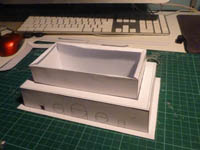 |
|
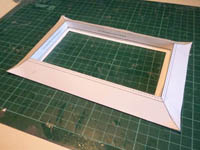 |
 |
|
|
| The first test build attempt came only this far. |
|
The first roof frame |
| |
|
|
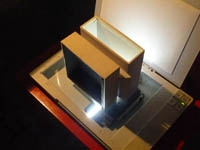 |
|
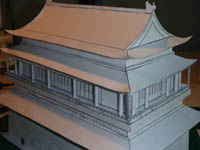 |
| |
|
|
| the very same roof frame being scanned |
|
This image shows how the roof edges looked before the roof edge parts were made. |
| |
|
|
|
The tricky part of the main tower were the roofs with lifted eaves and especially the roof edges. To get the round section on the roof edges right, I first built all roofs without edges. Then I placed them on the scanner with the thin edge, supported by two heavy glass bricks, to scan the edge. Based on the scan, the edge parts were created. They were adjusted several times by building only the frames later. The second addition to the second version of the patterns were the recessed doors in the ground floor, which also somewhat needed adjustment, as the length of the round part couldn't be measured accurately.
 |
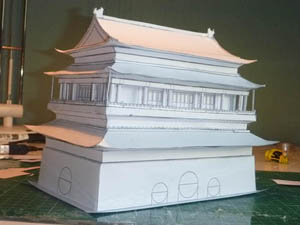 |
 |
The first complete build of the main tower, note again the roof edges lacking height.
 |
|
|
Another tricky part were the actual eaves. They were created in somewhat of a try-and-error method by creating eaves at different angles and trying out which fitted best. The height of the support structure was adjusted in this way as well.
Once the main tower was finished, the ramp and side structures could be created. The houses were easy, because they were all based on the same basic design. trickier were the gates, as they required the inner round part and more sophisticated roofs. Of the side structures only they required additional part test builds. Once these were made, the basic model was finished, but the greatest challenge remained: Making the white lively through the artwork, a task that seemed impossible to finish to me. So the design work rested ? for a long time. |
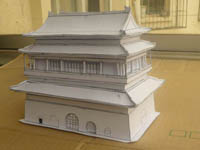 |
|
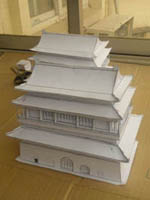 |
 |
|
|
| The second test build only needed minor correctionsl |
|
Both test builds together |
| |
|
|
|
It was not until after I had moved back to Germany, that I could get myself to start with the artwork. After I arrived in Germany, I had a lot of time between jobs. I thought, if i won't finish the Drum Tower now, it's probable I may never, so I thought I should at least start, even if it takes a half year to finish. Fortunately I had taken dozens of photos of every angle of the Drum Tower when I prepared doing the model, so I had very good source materials. I worked whole days for about one and a half weeks to get it all done, and it was exhausting, but I was very proud when I was finished.
The final built took me almost two months, because I didn't have a lot of time when my new job started, and the instructions had to be drawn at the same time. Just check the instructions file for the Drum Tower and you'll see how much work it was.
Now that the model is released, I'm quite proud of the work I invested in it. It's not only the biggest and most elaborate Stahlhart model so far, it's also a true work of art.
|
| |
| |
| return to top |
|
|
|
